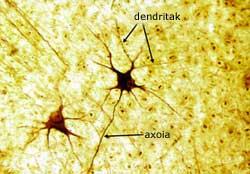New therapeutic destinations for multiple sclerosis
2002/10/01 Andonegi Beristain, Garazi - Elhuyar Zientziaren Komunikazioa Iturria: Elhuyar aldizkaria
Multiple sclerosis is an incurable disease that affects the central nervous system. It is the most common neurological disease among young adults and usually manifests between 20 and 40 years. In Spain it affects more than 30,000 people and affects more than a million worldwide. In addition, the evolution of the disease is tireless and varies in each patient; sometimes it hardly has symptoms; sometimes it can lead to complete paralysis.
This serious disease affects the white substance of the brain and spine, which contains the most myelin. Therefore, it is necessary to know what myelin is and how it affects the disease.
Multiple sclerosis and myeline

The function of myelin is to protect the axons or nerve extensions of neurons. In addition to this protective function, myelin also influences communication between neurons. So, when myelin is enough, communication between neurons is fast, but what happens when myelin is missing? The first conclusion is that communication between neurons slows down, that is, the axons are no longer able to quickly transport nerve quinadas. When these axons lose their communicative capacity they die and the death of the axon causes the death of the neuron itself. Therefore, the lack of myeline causes the death of neurons in the central nervous system.
But what causes myelin loss? One of the answers to this question can be found in this research with oligodendrocytes.
Discovery: the death of oligodendrocytes
Oligodendrocytes are important cells of the central nervous system. These cells are excited through receptors in the membrane and therefore synthesize myelin. Oligodendrocytes are therefore producers of myelin.
However, they have the particularity that if they become too excited, instead of producing more myelins, they become saturated, collapse and die. The death caused by this abusive excitement is precisely the new discovery made by this team of researchers.
Therapeutic goals
This discovery has paved the way for finding new therapeutic goals and are already in the first phase of clinical trials. One of the possible treatments can be the search for substances that resist exaggerated excitation, since the molecules that excite the oligodendrocytes are known, as well as their receptors. Therefore, adjusted inhibitory substances can save oligodendrocytes from death and thus prevent the loss of myelin.
This is the hope of a better quality of life for thousands of patients, since multiple sclerosis has serious repercussions on the economy and family of the sick. However, we must always keep in mind that we are still far from getting the total cure of the disease, but any discovery of it is a great step forward.
Project title: Objective:Discover Director: Working group:V. Department: Faculty: Faculty of Financing: UPV/EHU, |

Gai honi buruzko eduki gehiago
Elhuyarrek garatutako teknologia






